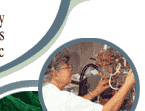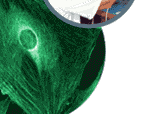|
PRESENTATION.ppt
PRESENTATION.pdf
General characteristic
The work is focused on the adhesion, proliferation and differentiation of cells in cultures and their changes induced by physiological and medically relevant pathological factors. The studies are performed on vascular smooth muscle and endothelial cells and bone-derived cells in cultures on artificial materials developed for replacements of the damaged vascular and bone tissue, including tissue engineering, i.e. an advanced technology considering the material as an analogue of the natural extracellular matrix, actively regulating cell functions.
Within the scope of the Joint Laboratory of Cancer Cell Biology, the correlation between the growth properties of brain tumor cells and the expression of multifunctional surface molecules of the DASH (Dipepdityl peptidase-IV Activity and/or Structure Homologues) family as well as gamma glutamyltranspeptidase is studied.
Methodologically, we use conventional as well as special light microscopic techniques, such as immunofluorescence, confocal microscopy, substrate enzyme histochemistry, immunoperoxidase cytochemistry. Also the flow cytometry, enzyme-linked immunosorbent assay (ELISA), vertical protein electrophoresis and immunoblotting are used. Other biochemical, molecular and electron microscopy techniques are provided by external collaboration with several domestic and foreign laboratories (see below).
Grant Projects and domestic collaborations:
The work is supported by 10 joint grants with the 1st and the 2nd Medical
Faculty of the Charles University, Institute of Chemical Technology, several institutes of the Academy of Sciences of the Czech
Republic (Institute of Macromolecular Chemistry, Institute of Rock Structure and Mechanics, Nuclear Physics Institute); Institute
of Nuclear Research, joint stock company; Czech Technical University in Prague, Institute of Organic Syntheses as well as the
industrial company Synthesia Pardubice, Czech Rep.
Other industrial partners, collaborating with us in our grant projects, are represented by the joint stock company VUP, Brno,
CR (supply of clinically used vascular prostheses for potential innovation), and Beznoska Ltd., Kladno, CR (metallic bone implants and their new surface modifications influencing their anchorage into the bone). A new collaboration has been established with the Technical University of Liberec, CR (nanofibres and nanofabrics for potential application in bone and vascular tissue engineering).
Also we collaborate with hospitals, mainly the Institute of Clinical and Experimental Medicine (IKEM), Prague, on the field of
the innovation of clinically used vascular prostheses and controlled delivery of antiproliferative drugs to vascular smooth muscle cells.
Since 1999, the Department of Growth and Differentiation of Cell Populations is a part of the Joint Laboratory of Cancer Cell
Biology, formed with the Department of Medical Chemistry of the 1st Medical Faculty of the Charles University. In addition,
some members of our Department are integrated into the Centre for Cardiovascular Research.
International collaborations:
Our laboratory has several foreign partners, for example:
Dept. of Biomaterials, AGH University of Science and Technology, Faculty of Materials Science and Ceramics, Krakow, Poland (development of carbon, polymeric and ceramic materials, including those nanostructured, for bone tissue engineering);
Université Victor Segalen, l'Unité INSERM 577, Laboratoire de Biophysique, Bordeaux, Francie (endothelialization of clinically used vascular prostheses, haemodynamic bench simulating blood flow through a vessel and shear stress);
Department of Chemistry, Shiga University of Medical Science (SUMS), Seta, Otsu, Shiga, Japan, Assoc. Prof. Naoki Komatsu (carbon nanoparticles, such as fullerenes, nanotubes and nanodiamonds for potential use in medicine and tissue engineering);
Univ. of Pennsylvania, Philadelphia, U.S.A., Prof. Dennis Discher (the role of cell spreading in the cell proliferation and differentiation, polymeric vesicles for controlled drug delivery);
Centro di Studio per l'Istochimica, C.N.R., Pavia, a University of Pavia, Italy, Prof. Carlo Pellicciari (flow cytometry of the cell cycle parameters, adhesion and cytoskeletal molecules as well as the markers of apoptosis).
Results
Innovation of clinically used blood vessel prostheses
We studied the possibilities of innovation of clinically used vascular prostheses, produced in VUP,
joint stock company, Brno, CR, knitted of polyethyleneterephtalate (PET). This material is relatively highly hydrophobic,
not allowing the formation of a continuous and mature endothelial cell layer on the inner surface of the prosthesis.
This surface was coated by 2D and 3D fibrin assemblies (which could be derived from the patient’s own blood) and seeded
with human endothelial cells obtained from the saphenous vein (seeding density of 158 000 cells/cm2). The number of initially
adhered endothelial cells was similar as on the uncoated prosthesis, but their resistance to the detachment by the medium flow
in the blood flow-simulating dynamic system (shear stress of 15 dyn/cm2) was significantly higher. For comparison, the
immobilization of laminin on the inner surface of prostheses increased the number of initially adhered endothelial cells
but did not change their resistance to the medium flow. However, on both protein types, a continuous layer of endothelial
cells was formed in two days after seeding.
Adhesion and growth of cells on biomaterials endowed with ligands for cell adhesion receptors
Vascular prostheses could be innovated not only by their coating by entire cell adhesion-mediating protein molecules, but
also by grafting of specific amino acid sequences, derived from these proteins (e.g. RGD-containing oligopeptides). In our
preliminary experiments performed in collaboration with the Institute of Macromolecular Chemistry, Acad. Sci CR, glass
coverslips were coated by polylactides and then by their copolymers with polyethylene oxide (PEO) in order to establish a
surface resistant to protein adsorption and non-controlled cell adhesion. Such a surface contained 33% of PEO (MW 11000).
Because of its extreme hydrophilia, this surface prevented adsorption of cell adhesion-mediating proteins from the serum
supplement of the culture medium and adhesion of vascular smooth muscle cells. However, when the ends of 5% or 20% of PEO
chains were covalently bound with the oligopeptide GRGDSG, a ligand for integrin adhesion receptors, the cell adhesion was
restored, and the ligand concentration influenced the number of initially adhered cells, size of the cell-material contact
area, the size, shape and distribution of talin- and vinculin-containing focal adhesion plaques as well as the subsequent
proliferation activity. These results suggest a possibility to control various cell functions by the concentration and spatial
distribution of adhesion oligopeptides on the biomaterial surface. In addition, chemical composition of the adhesion ligands
can lead to the preferential adhesion of a certain cell type (for example, the amino acid sequence REDV is preferred by
endothelial cells, KQAGDV by smooth muscle cells, KRSR by osteoblasts etc.).
Surface molecules of the plasma membrane and gama glutamyltranspeptidase in glioma cells
Within the Joint Laboratory of Cancer Cell Biology we found (l) non-homogeneous expression of the surface membrane molecules of
the DASH (Dipepdityl peptidase-IV Activity and/or Structure Homologs) family as well as gama glutamyltranspeptidase in glioma
cells in cultures derived from animal and human brain tumors. The presence and spectrum of these molecules depend on the
intensity of proliferation, stage of differentiation and metabolic stress of cells, such as the deprivation of growth
factors, presence of cytostatics etc. In addition, the expression of these molecules in bioptic samples of human brain
tumors is intensively studied in order to find new diagnostic and prognostic criteria of these disorders.
Research perspectives
We will continue the innovation of polymeric blood vessel prostheses currently
used in the clinical practice by reconstruction of tunica intima and possibly tunica media on these replacements. Adhesion
of vascular endothelial and smooth muscle cells to the prostheses will be supported by (a) defined and controlled immobilization
of extracellular and other cell adhesion-mediating molecules or (b) grafting of oligopeptidic ligands for cell adhesion receptors
(RGD, REDV) and their cooperating sequences (PHSRN) on the prosthesis material.
We intend to develop a new bioartificial vascular prosthesis based on synthetic
degradable polymers, such as polylactides and their copolymers with polyethylene oxide, functionalized with adhesion oligopeptides
preferred by endothelial or smooth muscle cells.
For purposes of the innovation and development of vascular replacements,
advanced dynamic cell culture systems (perfusion and rotational bioreactor) will be introduced in our tissue culture room. These
systems will enable to seed vascular cells homogeneously on the inner surface of vascular prostheses, followed by their exposure
to a defined flow of the culture medium as well as long-term shear, strain and pressure stress.
Within the Centre of Experimental Cardiovascular Research, we will
investigate the adhesion, growth and expression of differentiation markers in vascular smooth muscle cells (VSMC) in cultures
on extracellular matrix molecules damaged by oxidation or degradation (e.g., on collagen modified by activated mast cells) and
the role of VSMC in the onset and further development of vascular diseases, such as atherosclerosis and pulmonary as well as
systemic hypertension.
Also bioartificial bone replacements, i.e. implants containing
artificial material as well as cells and other biological components, will be constructed using three-dimensional porous
materials (especially polymers reinforced with carbon fibres or fabric, polymer-ceramic composites). Special attention
will be paid to the replacements with hierarchically organized micro- and nanostructure corresponding to the architecture
of the natural bone tissue (for example, walls of the pores of the diameter of hundreds of micrometers will be decorated
with nanoparticles, e.g. hydroxyapatite nanocrystals). This architecture is expected to improve the ingrowth and maturation
of osteoblasts inside the material, especially in the above mentioned dynamic rotational or perfusion cell culture systems.
In so-called two-dimensional bone implants (i.e., allowing colonization with bone cells only on their surface), surface
modification either supporting or delaying their integration with the surrounding bone tissue will be devel
oped in cooperation with physical and chemical institutions and the Beznoska company, Ltd.
Adhesion, growth and differentiation of vascular and bone cells will be also studied on various other
biomimetic surfaces, such as ion- or UV light-irradiated polymers including those irradiated through masks with gaps of
various size and shape and distribution in order to create surfaces patterned with microdomains ether adhesive or
non-adhesive for cells. Special attention will be paid to nanostructured surfaces created e.g. by deposition
of carbon nanoparticles (fullerenes, nanotubes and nanodiamonds).
In the frame of the Joint Laboratory Program, we will continue studies on the Dipepdityl
peptidase-IV Activity and/or Structure Homologs (DASH) as well as gamma glutamyltranspeptidase in the plasma
membrane and their role in the control of proliferation and invasiveness in brain tumors.
Publications
|




